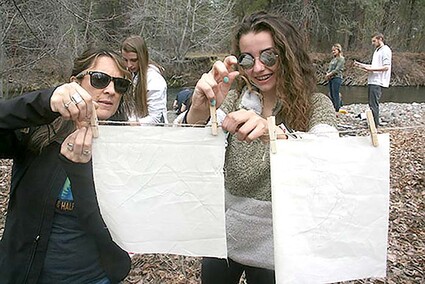The art and science of watersheds
Last updated 4/30/2019 at Noon

Jim Anderson
Samra Spear and Joelle Asson drying their batik fabrics as part of a recent IEE excursion to Whychus Creek.
The students of Sisters are on a quest to learn more about our local waters with the help of Kolleen Miller, education director of the Upper Deschutes Watershed Council, and her fellow educators.
Water development projects are the backbone of agriculture in Sisters Country, and it’s vital that students understand the mechanics and biology of water in our lives.
Within the high school’s tool box of learning there is a host of educational resources that every one of the students has access to.
Last Monday, one of those educational tool boxes popped open again: The Interdisciplinary Environmental Expedition (I.E.E.), led by science teacher Samra Spear. It’s a course composed of a group of community learners working together to provide students with a balanced, in-depth understanding of the world around them.
Spear and her Outlaw IEE students climbed on their bikes and rode off to the banks of Whychus Creek on the Pine Meadow Ranch property, where they were met by a team of education volunteers.
Kolleen Miller and her team have been working with the Sisters Outlaws IEE program for several years, opening the doors to natural resource conservation and learning together to make it a project that not only meets educational goals but also provides artful windows in the future for the students.
She has been working with the foundation and high school students of the area since 1996, and she has seen the goals of her job come to life: “I have been working with students along rivers and streams for 17 years. My belief in the importance of connecting kids to nature is just as strong today as it was on the very first day I walked along a stream with 6-year- olds up in Alaska. Whether six or 16, all students benefit from spending time in nature. Internally, students develop an inspired sense of self and, externally, our environment gains informed and engaged stream stewards.”
As an example, through the use of poetry, essays, music and several other forms of art, each student takes on a personal watershed project to his or her liking, and in-depth methods of exploration — such as, “What is a watershed? ”
They understand and can see the answer in art forms as well as in scientific details: It’s a land area that channels rainfall and snowmelt to creeks, streams, and rivers, and eventually to outflow points such as reservoirs, bays, and the ocean — and the Sisters community has seen the results of the violent overflow of Whychus Creek’s watershed in the not-too-distant past.
IEE students learn that while some watersheds are relatively small, others encompass thousands of square miles, containing streams, rivers, lakes, reservoirs, and underlying groundwater that are hundreds of miles inland, such as the Upper Deschutes Watershed.
The students are learning that the size of a watershed (also called a drainage basin or catchment) is defined on several scales — referred to as its Hydrologic Unit Codes (HUC)—which is based on the geography that is most relevant to the specific area.
Since 1996, the Upper Deschutes Watershed Council has worked to protect and restore over 2 million acres of waterways through collaborative projects in watershed restoration, monitoring and community awareness. This grass-roots approach ensures that all parties involved — including high school students — can work together to create effective management strategies for watersheds.
IEE students are right in the middle of all these efforts, exacting the science, creating poems and essays, making music and learning in an environment that creates a variety of choices and decisions that they can make, and cause it all to happen to bring about conservation to the land they are learning to love.
This particular IEE project began on April 16, and has taken the students onto the banks of Whychus Creek four times. On each trip they were challenged to do everything they can to bring their studies into their personal lives using the various art forms.
Alyssa Grove, one of Miller’s educational assistants, is in the process of teaching the students the art of Batik — an art form that involves painting symbolic designs on fabric. The fabric is printed by a 2,000-year-old Indonesian method of hand-printing textiles by coating with wax the parts not to be dyed.
Miller, Spear and their teams will be planning a big night out for the students at the regional Watershed Summit to demonstrate their knowledge of water management and perform their songs, read their essays and poetry and celebrate the wonderful times that they had taking part in the IEE program.











Reader Comments(0)